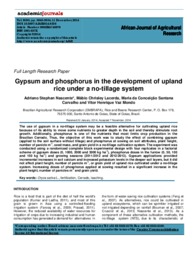Gypsum and phosphorus in the development of upland rice under a no-tillage system.
Gypsum and phosphorus in the development of upland rice under a no-tillage system.
Author(s): NASCENTE, A. S.; LACERDA, M. C.; CARVALHO, M. da C. S.; MONDO, V. H. V.
Summary: The use of gypsum in a no-tillage system may be a feasible alternative for cultivating upland rice because of its ability to move some nutrients to greater depth in the soil and thereby stimulate root growth. Additionally, phosphorus is one of the nutrients that most limits crop production in the Brazilian Cerrado. Thus, the objective of this work was to study the effect of combining gypsum (applied to the soil surface without tillage) and phosphorus at sowing on soil attributes, plant height, number of panicle m-1, seed mass, and grain yield in a no-tillage cultivation system. The experiment was conducted using a randomized complete block experimental design with four replicates in a factorial scheme of gypsum doses (0, 1000, 2000 and 3000 kg ha-1), phosphorus doses in the furrow (0, 50, 100 and 150 kg ha-1) and growing seasons (2011/2012 and 2012/2013). Gypsum applications provided incremental increases in soil calcium and increased potassium levels in the deeper soil layers, but it did not affect plant height, number of panicle m-1, or grain yield of upland rice cultivated under a no-tillage system. Increasing doses of phosphorus applied at sowing resulted in a significant increase in the plant height, number of panicles m-1 and grain yield.
Publication year: 2014
Types of publication: Journal article
Unit: Embrapa Rice & Beans
Keywords: Arroz, Fertilidade do solo, Fósforo, Lixiviação, Oryza sativa, Plantio direto
Observation
Some of Embrapa's publications are published as ePub files. To read them, use or download one of the following free software options to your computer or mobile device. Android: Google Play Books; IOS: iBooks; Windows and Linux: Calibre.
Access other publications
Access the Agricultural Research Database (BDPA) to consult Embrapa's full library collection and records.
Visit Embrapa Bookstore to purchase books and other publications sold by Embrapa.

